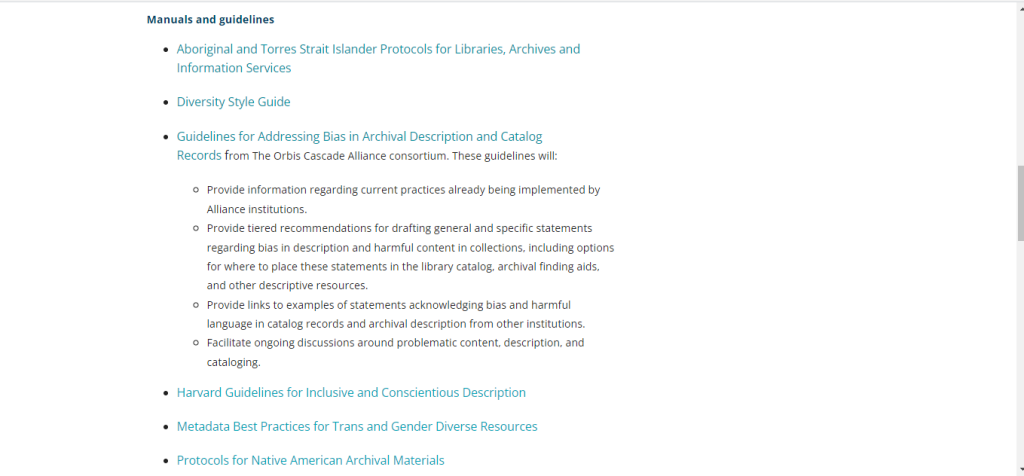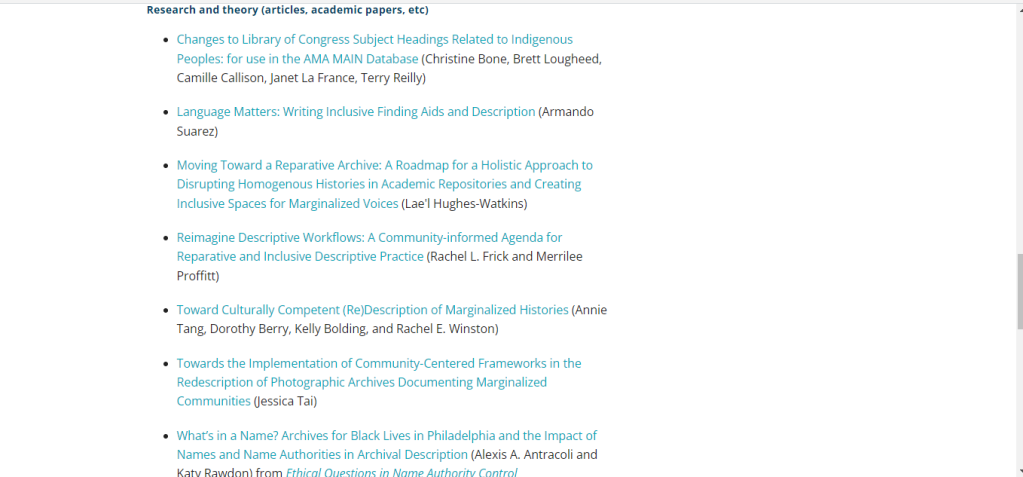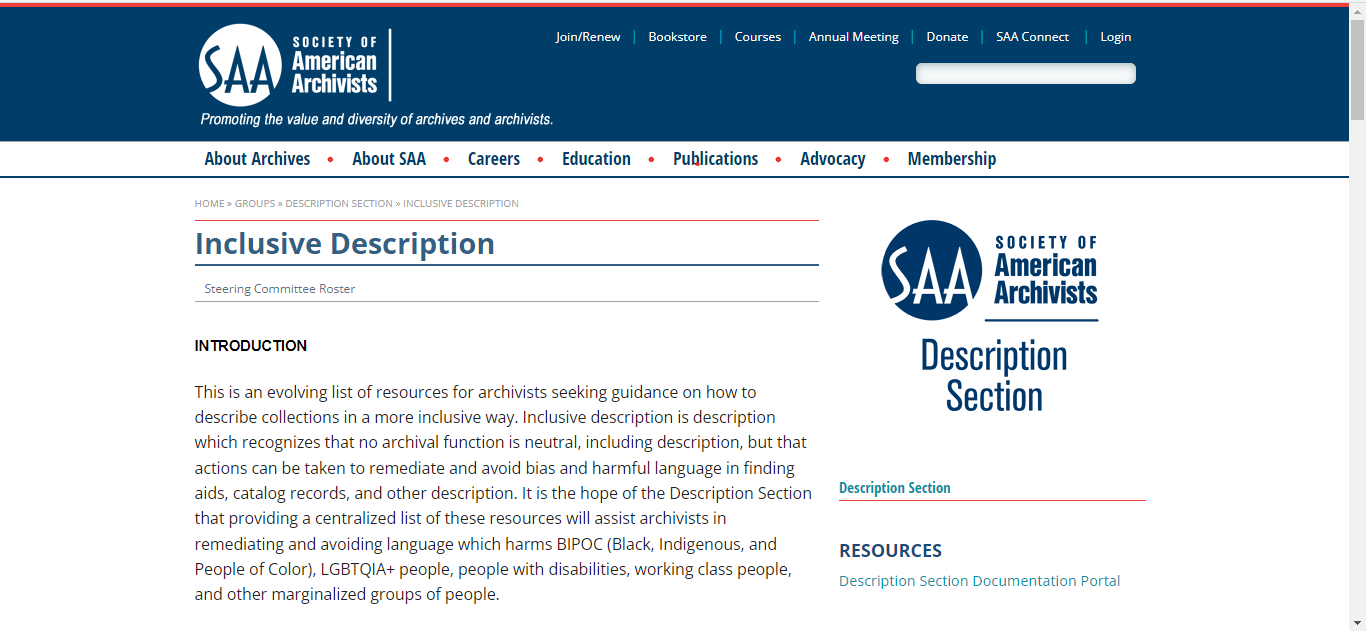By Betts Coup
Anyone up for a quick tour? The Steering Committee of the Description Section would like to offer a very brief walkthrough of one portion of our Documentation Portal, our Inclusive Description page, especially as we’re asking members to submit additional resources to help expand and update the list of materials we already include.
In case our readers aren’t familiar, the Description Section Documentation Portal is a community-driven site that includes a wide variety of documentation related to archival description, from archival processing manuals and workflow documentation to guides and guidelines. The Portal makes available documentation shared by the Description Section membership on a variety of topics, which have been divided into several handy sections:
- Inclusive Description
- Archival Processing Manuals
- Checklists and Templates
- Guidelines for Specific Formats
- Comprehensive Documentation
Though each and every one of these pages contains valuable resources, this post will focus specifically on the Inclusive Description Portal, where one can find a group of resources that offer guidance and information about describing archival materials in a more inclusive manner. As the Portal’s description explains, “Inclusive description is description which recognizes that no archival function is neutral, including description, but that actions can be taken to remediate and avoid bias and harmful language in finding aids, catalog records, and other description.” Over the past several years, archivists have increasingly considered the problems of archival neutrality and silence and ways to remediate these – and to change the ethos and approach to archival description as we move forward. The Inclusive Description Portal includes materials about reparative archival descriptive work, from projects to principles for editing and updating description, as well as resources relating to creating new description inclusively and conscientiously.
The Inclusive Description Portal includes several groupings of types of materials, which at the time of publication in March 2023 are: Case Studies, Manuals and Guidelines, Research and Theory (articles, academic papers, etc.), Resource Lists, and Sample Statements about harmful language in archival description. As with all pages on the overall Documentation Portal, the contents of the Inclusive Description page have been crowd-sourced, received as submissions by members of the Description Section and others. The Description Section Steering Committee reviews submissions to the best of their ability, but what you find on the Portal are not necessarily resources endorsed by SAA or the Description Section.
For a quick tour, we’ll cover briefly what you might find in each of these sections at the moment.
Under Case Studies, there are conference presentations on cataloging practices, the documentary Change The Subject about Library of Congress Subject Headings and the activists working to change them, a progress report from Princeton University Library’s inclusive description working group, and an article Courtney Dean wrote for the Description Section’s then-newsletter Descriptive Notes on descriptions of Japanese American Collections at UCLA.

The Manuals and Guidelines section includes guidelines and practical documentation for the description of specific communities and groups, as well as more general practices and principles for inclusive description from regional consortiums, institutions, and more. Included in this section are resources such as the Aboriginal and Torres Strait Islander Protocols for Libraries, Archives and Information Services, a set of Australian guidelines created and maintained by the Aboriginal and Torres Strait Islander Library, Information and Resource Network Inc.; the Protocols for Native American Archival Materials and additional resources relating to description of materials relating to Indigenous groups; and the Diversity Style Guide, a resource intended to help media professionals to write more accurately.

The Research and Theory portion of the Portal contains articles and academic papers focused on inclusive and reparative description, with topics ranging from Library of Congress subject headings to writing finding aids and considering community-centered frameworks in descriptive work.

Resources include the (newly SAA-endorsed External Standard) Archives for Black Lives in Philadelphia Anti-Racist Description Resources and presentations and YouTube videos from the Sunshine State Digital Network’s sessions on inclusive metadata.

Finally, one can find a group of sample statements about harmful language in archival description, with a list as well as statements from Princeton University Library and Temple University.

As mentioned above, the Inclusive Description Portal is crowd-sourced, and the Description Section Steering Committee is actively seeking submissions of additional materials! We hope that this Portal can represent a centralized list of resources that will support archivists doing remediation work and attempting to rethink approaches to new archival description. To do that, this list has to expand to include the wide variety of resources being created by archival professionals (and beyond) impacting descriptive practice.
The Description Section Steering Committee would love to have further submissions to add to and update the Portal across the breadth of writing about inclusive description. Resources can fall easily under one of the existing categories described above (case studies, manuals and guidelines, research and theory [articles or academic papers], resource lists, and sample statements about harmful language in archival description), but we also welcome any type of resource on the topic of inclusive description you would like to submit. The SAA Description Section Steering Committee will review submissions to ensure they are appropriate for the Portal, while acknowledging our own bias as well as limitations on our time to review resources in their entirety. As is stated on the Portal, “Resources provided herein are shared with the intention of promoting respect for all people.”
If you would like to submit a resource relating to inclusive archival description, please email the Description Section Steering Committee at saadescription@gmail.com with a link or attachment of the documentation, as well as the institution and repository (if applicable), and a brief summary of the documentation.
We also encourage our Section membership to provide feedback on the resources included in the Portal. If you believe any of the resources maligns any group, individual or community, or conflicts with the SAA Core Values Statement and Code of Ethics, please bring this to our attention at the above email. The Portal is intended to be an inclusive, living forum where archivists can turn to find information that supports their descriptive work, and we appreciate your submissions and feedback that make that possible.
Betts Coup is the Interim Head of the Manuscript Section at Houghton Library, Harvard University. She currently oversees archival processing and generally specializes in archival description, access, and use. She is a Member-at-Large of both the SAA Description Section Steering Committee and Encoded Archival Standards Section Steering Committee, and active in the formation of the new SAA User Experience Section. Betts holds an MLIS from the Simmons University School of Library and Information Science and an MA from the Institute of Fine Arts at New York University.


3 thoughts on “Introduction to the SAA Description Section Portal: Inclusive Description”